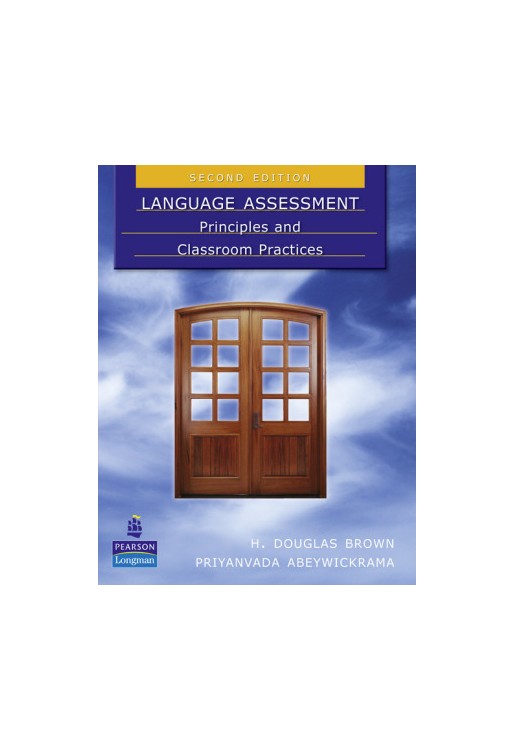


Language Assessment: Principles and Classroom Practices, offers a clear, comprehensive survey of the essential principles of assessing second language learning, as well as the critical tools teachers need to evaluate performance fairly and effectively. This invaluable resource joins Brown's classic texts, Principles of Language Learning and Teaching and Teaching by Principles, in providing indispensible guidance for second language instruction.
Language Assessment provides a working knowledge of the principles of assessment and their practical application in the classroom. This concise, comprehensive treatment of all four skills includes classification of assessment techniques ranging from controlled to open-ended item types, while a discussion of standardized tests examines their design, purpose, validity and utility.
Additional key features:
Chapter 1: Assessment Concepts and Issues
Assessment and Testing
Measurement and Evaluation
Assessment and Learning
Informal and Formal Assessment
Formative and Summative Assessment
Norm-Referenced and Criterion-Referenced Tests
Types and Purposes of Assessment
Achievement Tests
Diagnostic Tests
Placement Tests
Proficiency Tests
Aptitude Tests
Issues in Language Assessment: Then and Now
Behavioral Influences on Language Testing
Integrative Approaches
Communicative Language Testing
Performance-based Assessment
Current “Hot Topics” in Classroom-based Assessment
Multiple Intelligences
Traditional and “Alternative” Assessment
Computer-based Testing
Other Current Issues
Exercises
For Your Further Reading
Chapter 2: Principles Of Language Assessment
Practicality
Reliability
Student-Related Reliability
Rater Reliability
Test Administration Reliability
Test Reliability
Validity
Content-Related Evidence
Criterion-Related Evidence
Construct-Related Evidence
Consequential Validity (Impact)
Face Validity
Authenticity
Washback
Applying Principles to the Evaluation of Classroom Tests
Exercises
For Your Further Reading
Chapter 3: Designing Classroom Language Tests
Four Assessment Scenarios
Determining the Purpose of a Test
Designing Clear, Unambiguous Objectives
Drawing Up Test Specifications
Devising Test Items
Designing Multiple-Choice Items
Administering the Test
Scoring, Grading, and Giving Feedback
Scoring
Grading
Giving Feedback
Exercises
For Your Further Reading
Chapter 4: Standards-Based Assessment
The Role of Standards in Standardized Tests
Standards-Based Education
Designing English Language Standards
Standards-Based Assessment
CASAS and SCANS
Teacher Standards
The Consequences of Standards-Based and Standardized Testing
Test Bias
Test-Driven Language and Teaching
Ethical Issues: Critical Language Testing
Exercises
For Your Further Reading
Chapter 5: Standardized Testing
Advantages and Disadvantages of Standardized Tests
Developing a Standardized Test
Standardized Language Proficiency Testing
Exercises
For Your Further Reading
Chapter 6: Beyond Tests: Alternatives in Assessment
The Dilemma of Maximizing Both Practicality and Washback
Performance-Based Assessment
Rubrics
Portfolios
Journals
Conferences and Interviews
Observations
Self- and Peer-Assessments
Types of Self- and Peer-Assessment
Guidelines for Self- and peer-Assessment
A Taxonomy of Self- and Peer-Assessment Tasks
Exercises
For Your Further Reading
Chapter 7: Assessing Listening
Integration of Skills in Language Assessment
Assessing Grammar and Vocabulary
Observing the Performance of the Four Skills
The Importance of Listening
Basic Types of Listening
Micro- and Macroskills of Listening
Designing Assessment Tasks: Intensive Listening
Recognizing Phonological and Morphological Elements
Paraphrase Recognition
Designing Assessment Tasks: Responsive Listening
Designing Assessment Tasks: Selective Listening
Listening Cloze
Information Transfer
Sentence Repetition
Designing Assessment Tasks: Extensive Listening
Dictation
Communicative Stimulus-Response Tasks
Authentic Listening Tasks
Exercises
For Your Further Reading
Chapter 8: Assessing Speaking
Basic Types of Speaking
Micro- and Macroskills of Speaking
Designing Assessment Tasks: Imitative Speaking
Versant ®
Designing Assessment Tasks: Intensive Speaking
Directed Response Tasks
Read-Aloud Tasks
Sentence/Dialogue Completion Tasks and Oral Questionnaires
Picture-Cued Tasks
Translation (of Limited Stretches of Discourse)
Designing Assessment Tasks: Responsive Speaking
Question and Answer
Giving Instructions and Directions
Paraphrasing
Test of Spoken English (TSE ®)
Designing Assessment Tasks: Interactive Speaking
Interview
Role Play
Discussions and Conversations
Games
ACTFL Oral Proficiency Interview (OPI)
Designing Assessments: Extensive Speaking
Oral Presentations
Picture-Cued Story-Telling
Retelling a Story, News Event
Translation (of Extended Prose)
Exercises
For Your Further Reading
Chapter 9: Assessing Reading
Genres of Reading
Microskills, Macroskills, and Strategies for Reading
Types of Reading
Designing Assessment Tasks: Perceptive Reading
Reading Aloud
Written Response
Multiple-Choice
Picture-Cued Items
Designing Assessment Tasks: Selective Reading
Multiple Choice (for Form-Focused Criteria)
Matching Tasks
Editing Tasks
Picture-Cued Tasks
Gap-Filling Tasks
Designing Assessment Tasks: Interactive Reading
Cloze Tasks
Impromptu Reading Plus Comprehension Questions
Short-Answer Tasks
Editing (Longer Texts)
Scanning
Ordering Tasks
Information Transfer: Reading Charts, Maps, Graphs, Diagrams
Designing Assessment Tasks: Extensive Reading
Skimming Tasks
Summarizing and Responding
Note-Taking and Outlining
Exercises
For Your Further Reading
Chapter 10: Assessing Writing
Genres of Written Language
Types of Writing Performance
Micro- and Macroskills of Writing
Designing Assessment Tasks: Imitative Writing
Tasks in [Hand] Writing Letters, Words, and Punctuation
Spelling Tasks and Detecting Phoneme-Grapheme Correspondences
Designing Assessment Tasks: Intensive (Controlled) Writing
Dictation and Dicto-Comp
Grammatical Transformation Tasks
Picture-Cued Tasks
Vocabulary Assessment Tasks
Ordering Tasks
Short-Answer and Sentence Completion Tasks
Issues in Assessing Responsive and Extensive Writing
Designing Assessment Tasks: Responsive and Extensive Writing
Paraphrasing
Guided Question and Answer
Paragraph Construction Tasks
Strategic Options
Scoring Methods for Responsive and Extensive Writing
Holistic Scoring
Primary Trait Scoring
Analytic Scoring
Beyond Scoring: Responding to Extensive Writing
Assessing Initial Stages of the Process of Composing
Assessing Later Stages of the Process of Composing
Exercises
For Your Further Reading
Chapter 11: Assessing Grammar and Vocabulary
Assessing Grammar
Defining Grammatical Knowledge
Designing Assessment Tasks: Selected Response
Multiple-Choice (MC) Tasks
Discrimination Tasks
Noticing Tasks or Consciousness Raising Tasks
Designing Assessment Tasks: Limited Production
Gap-filling Tasks
Short Answer Tasks
Dialogue Completion Tasks
Designing Assessment Tasks: Extended Production
Information-gap Tasks
Role Play or Simulation Tasks
Assessing Vocabulary
The Nature of Vocabulary
Defining Lexical Knowledge
Some Considerations in Designing Assessment Tasks
Designing Assessment Tasks: Receptive Vocabulary
Designing Assessment Tasks: Productive Vocabulary
Exercises
For Your Further Reading
Chapter 12: Grading and Student Evaluation
Philosophy of Grading: What Should Grades Reflect?
Guidelines for Selecting Grading Criteria
Methods for Calculating Grades
Teachers’ Perceptions of Appropriate Grade Distributions
Institutional Expectations and Constraints
Cross-Cultural Factors and the Question of Difficulty
What Do Letter Grades “Mean”?
Calculating Grades
Alternatives to Letter Grading
Some Principles and Guidelines for Grading and Evaluation
Exercises
For Your Further Reading
Appendix: Commercial Tests
Glossary
Bibliography
Name Index
Subject Index